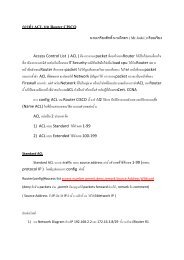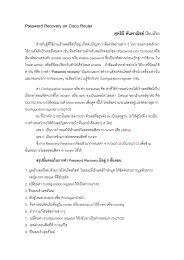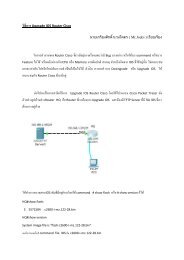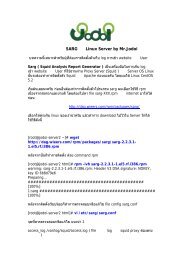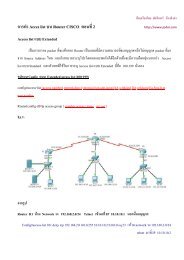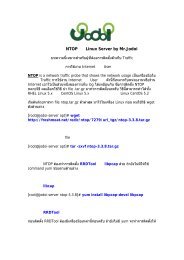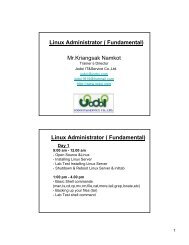You also want an ePaper? Increase the reach of your titles
YUMPU automatically turns print PDFs into web optimized ePapers that Google loves.
<strong>IP</strong> <strong>Address</strong><br />
<strong>IP</strong> <strong>Address</strong> Internet Protocol <strong>Address</strong> <br />
<strong>IP</strong> <strong>Address</strong> <br />
Network Router, Switch , Firewall , <strong>IP</strong> Camera , <strong>IP</strong> Phone , Access<br />
point , <strong>IP</strong><br />
<strong>Address</strong> <strong>IP</strong> <strong>Address</strong> <strong>IP</strong>v4<br />
(<strong>IP</strong> version 4) <strong>IP</strong>v6 (<strong>IP</strong> version 6) <br />
<strong>IP</strong> <strong>Address</strong> <strong>IP</strong>v6<br />
<strong>IP</strong> <strong>Address</strong> Asia Pacific APNIC <br />
Internet ISP <strong>IP</strong> APNIC ISP <br />
Certificate CCNA , CCNP , LPI , Security + , CWNA<br />
<strong>IP</strong> <strong>Address</strong> <strong>IP</strong>v4 <br />
<br />
<strong>IP</strong>v4<br />
<strong>IP</strong>v4 32 bits (4 bytes ,( 8bits=1byte)) 4 8 bits <br />
Dot <br />
0 00000000 . 00000000 . 00000000 . 00000000<br />
1 11111111 . 11111111 . 11111111 . 11111111<br />
10 <br />
0 0.0.0.0<br />
1 255.255.255.255<br />
<strong>IP</strong>v4 0.0.0.0 – 255.255.255.255
<strong>IP</strong> <br />
<strong>IP</strong>v4 0.0.0.0 - 255.255.555.555<br />
<strong>IP</strong>v4 5 5 Class byte 1 <br />
class A byte 1 0<br />
class B byte 1 1 2 0<br />
class C byte 1 2 1 3 0<br />
class D byte 1 3 1 4 0<br />
class E byte 1 4 1
<strong>IP</strong> Class <br />
Class A 0.0.0.0 127.255.255.255<br />
Class B 128.0.0.0 191.255.255.255<br />
Class C 192.0.0.0 223.255.255.255<br />
Class D 224.0.0.0 239.255.255.255<br />
Class E 240.0.0.0 255.255.255.255<br />
<strong>IP</strong> Set Host 3 Class Class A, B C <strong>IP</strong> Class<br />
D multicast applications <strong>IP</strong> Class E <br />
<br />
<strong>IP</strong>v4 2 Public <strong>IP</strong> ( <strong>IP</strong> ) Private <strong>IP</strong> ( <strong>IP</strong> )<br />
Public <strong>IP</strong> ( <strong>IP</strong> ) <strong>IP</strong> set network Server Router <br />
Public <strong>IP</strong> ( <strong>IP</strong> ) Network Internet <br />
Private <strong>IP</strong> ( <strong>IP</strong> ) set PC <br />
Public <strong>IP</strong> Internet Gateway Router ,Server Modem<br />
DSL Service NAT ( ) Internet <br />
Private <strong>IP</strong> Class A,B C <br />
Class A : 10.x.x.x ( 10.0.0.0 - 10.255.255.255 )<br />
Class B : 172.16.x.x - 172.31.x.x ( 172.16.0.0 - 172.31.255.255 )<br />
Class C : 192.168.x.x ( 192.168.0.0 - 192.168.255.255 )<br />
<strong>IP</strong>v4<br />
<strong>IP</strong> <strong>Address</strong> 1 <strong>IP</strong> <strong>Address</strong> <br />
Subnet Mask <strong>IP</strong> <strong>Address</strong> <br />
Network <strong>IP</strong> <strong>IP</strong> <strong>Address</strong> <br />
Broadcast <strong>IP</strong> <strong>IP</strong> <strong>Address</strong> <br />
Range host <strong>IP</strong> <strong>IP</strong> <br />
Subnets , hosts / Subnet<br />
Subnet Mask network <strong>IP</strong> <strong>Address</strong> <br />
4 255.255.255.0 computer <br />
network subnet Subnet Mask
Subnet Mask<br />
/30 mask 30 bits <br />
/27 mask 27 bits <br />
/20 mask 20 bits <br />
mask bit Subnet Mask<br />
bits mask 1 bits 0<br />
Ex /30<br />
/30 11111111 . 11111111 . 11111111 . 111111/00<br />
Subnet Mask<br />
/30 255.255.255.252<br />
11111111 . 11111111 . 11111111 . 111111/00<br />
1 8 255<br />
1 6 252 24 bits 1 <br />
bits 30 252 <br />
Ex /27<br />
/27 11111111 . 11111111 . 11111111 . 111/00000<br />
Subnet Mask<br />
/27 255.255.255.224
Ex /20<br />
/20 11111111 . 11111111 . 1111/0000 . 00000000<br />
Subnet Mask<br />
/20 255.255.240.0<br />
Subnet Mask <br />
Mask default <strong>IP</strong> Class<br />
Class A = Mask 8 bits = 255 . 0 . 0 . 0<br />
Class B = Mask 16 bits = 255 . 255 . 0 . 0<br />
Class C = Mask 24 bits = 255 . 255 . 255 . 0<br />
Subnet mask <br />
Mask 10 = 255 . 192 . 0 . 0 Mask 21 = 255 . 255 . 248 . 0<br />
Mask 11 = 255 . 224 . 0 . 0 Mask 22 = 255 . 255 . 252 . 0<br />
Mask 12 = 255 . 240 . 0 . 0 Mask 23 = 255 . 255 . 254 . 0<br />
Mask 13 = 255 . 248 . 0 . 0 Mask 25 = 255 . 255 . 255 . 128<br />
Mask 14 = 255 . 252 . 0 . 0 Mask 26 = 255 . 255 . 255 . 192<br />
Mask 15 = 255 . 254 . 0 . 0 Mask 27 = 255 . 255 . 255 . 224<br />
Mask 17 = 255 . 255 . 128 . 0 Mask 28 = 255 . 255 . 255 . 240<br />
Mask 18 = 255 . 255 . 192 . 0 Mask 29 = 255 . 255 . 255 . 248<br />
Mask 19 = 255 . 255 . 224 . 0 Mask 30 = 255 . 255 . 255 . 252<br />
Mask 20 = 255 . 255 . 240 . 0 Mask 31 = 255 . 255 . 255 . 254<br />
1<br />
255 1 4 240 0 0<br />
Subnet Mask Network <strong>IP</strong> Broadcast <strong>IP</strong><br />
Network <strong>IP</strong> <strong>IP</strong> Subnet Routing <br />
Set PC
Broadcast <strong>IP</strong> <strong>IP</strong> Subnet Broadcast <br />
Set PC <br />
Ex.1 192.168.22.50/30<br />
30 Subnet Mask 255.255.255.252<br />
1 8 255 ( <br />
1 6 252 subnet mask 255.255.255.252<br />
<strong>IP</strong> Subnet Subnet Mask <br />
2 bit 00 , 01 , 10 , 11 4 <br />
00 , 01 , 10 , 11 <br />
00 0<br />
01 1<br />
10 2<br />
11 3<br />
<strong>IP</strong> Subnet Subnet Mask 255.255.255.252 4 <br />
252 4 <br />
30 <strong>IP</strong> subnet <br />
0-3 , 4-7 , 8-11 , _ _ _ , 252-255 <strong>IP</strong>v4 <br />
192.168.22.0 - 192.168.22.3<br />
192.168.22.4 - 192.168.22.7<br />
192.168.22.8 - 192.168.22.11<br />
-----------<br />
192.168.22.48 - 192.168.22.51<br />
---------<br />
192.168.22.252 - 192.168.22.255
3 and bit 3 bit 1<br />
add 3 10 <br />
<strong>IP</strong> <strong>Address</strong> subnet Network <strong>IP</strong> <strong>IP</strong> <strong>Address</strong> <br />
subnet Broadcast <strong>IP</strong> <br />
192.168.22.50/30<br />
1. Network <strong>IP</strong> <strong>IP</strong> <strong>Address</strong> <br />
192.168.22.48<br />
2. Broadcast <strong>IP</strong> <strong>IP</strong> <strong>Address</strong> <br />
192.168.22.51<br />
3. Range hosts <strong>IP</strong> hosts Per Subnet<br />
192.168.22.49 - 192.168.22.50 <strong>IP</strong> set host 2 <strong>IP</strong><br />
Network <strong>IP</strong> <br />
Subnet Mask AND <strong>IP</strong> <strong>Address</strong> <br />
Network <strong>IP</strong> <br />
<strong>IP</strong> <strong>IP</strong> Subnet <br />
192.168.22.50/30 50 4 <br />
Netwok <strong>IP</strong> /30 1 subnet <br />
<strong>IP</strong> 4
Ex.2 192 .168.5.33/27 which <strong>IP</strong> address should be assigned to the PC host ?<br />
A.192.168.5.5<br />
B.192.168.5.32<br />
C. 192.168.5.40<br />
D. 192.168.5.63<br />
E. 192.168.5.75<br />
27 <br />
11111111 . 11111111 . 11111111 . 111/XXXX X = mask 27 bit 1 5<br />
bit <br />
/27 255 . 255 . 255 . 224<br />
4 bit 8 bit 111 <br />
128+64+32 = 224<br />
Subnet Mask <strong>IP</strong> Subnet 32 <br />
224 32 <br />
192 .168.5.33/27 Network <br />
192.168.5.33/27 192.168.5.32 - 192.168.5.63<br />
<strong>IP</strong> Network <strong>IP</strong> ( 192.168.5.32 ) <strong>IP</strong> Broadcast <strong>IP</strong> (<br />
192.168.5.63 ) set PC <strong>IP</strong> Set PC <br />
192.168.5.33 - 192.168.5.62<br />
C. 192.168.5.40<br />
Ex.3 <strong>IP</strong> 10.10.10.0/13 <strong>IP</strong> set host <br />
<strong>IP</strong> set host Network <strong>IP</strong> <br />
Broadcast <strong>IP</strong><br />
13 mask 13 bit subnet mask
11111111 . 11111/XXX . XXXXXXXX . XXXXXXXX = mask 13 bit<br />
1 bit <br />
/13 255 . 248 . 0 . 0<br />
<strong>IP</strong> 10.10.10.0 subnet mask 255.248.0.0<br />
<strong>IP</strong> subnet mask 255.248.0.0<br />
1 10 3 4 0 - 255<br />
2 <strong>IP</strong> <br />
10 . X . 0 . 0 - 10 . X . 255 . 255<br />
248 ( 2 ) 3 <strong>IP</strong> <br />
8 0-7 , 8-15 , 16- 23 , _ _ _ , 248-255 <br />
10 . 0 . 0 . 0 - 10 . . 255 . 255<br />
10 . 8 . 0 . 0 - 10 . . 255 . 255 ------------> <br />
10 . 16 . 0 . 0 - 10 . . 255 . 255<br />
------------<br />
10 . 248 . 0 . 0 - 10 . . 255 . 255<br />
10.10.10.0/13 <strong>IP</strong> 10 .8 . 0 . 0 - 10 . 15 . 255 . 255<br />
1. Network <strong>IP</strong> <strong>IP</strong> <strong>Address</strong> <br />
10 . 8 . 0 . 0<br />
2. Broadcast <strong>IP</strong> <strong>IP</strong> <strong>Address</strong> <br />
10 . 15 . 255 . 255<br />
3. Range host <strong>IP</strong> <br />
10 . 8 . 0 . 1 - 10 . 15 . 255 . 254 <strong>IP</strong> 10.10.10.0/13 <br />
Host
Subnet hosts / Subnet<br />
hosts Subnet Subnet Mask<br />
2 n - 2<br />
n bits Mask 2 Network <strong>IP</strong> Broadcast <strong>IP</strong><br />
Ex.1 /30 11111111 . 11111111 . 11111111 . 111111/00<br />
255.255.255.252 <br />
hosts/Subnet = 2 n - 2 = 2 2 - 2 = 4 - 2 = 2<br />
Ex.2 /20 11111111 . 11111111 . 1111/0000 . 00000000<br />
255.255.240.0<br />
hosts/Subnet = 2 n - 2 = 2 12 - 2 = 4096 - 2 = 4094<br />
Subnet Subnet Mask <br />
2 n 2 Subnet router cisco <br />
<strong>IP</strong> Subnet Zero <br />
n bits Mask . (dot) <br />
Ex.3 /30 11111111 . 11111111 . 11111111 . 111111/00<br />
255.255.255.252 <br />
Subnet = 2 n = 2 6 = 64<br />
Ex.4 /20 11111111 . 11111111 . 1111/0000 . 00000000<br />
255.255.240.0<br />
Subnet = 2 n = 2 4 = 16<br />
Ex.5 /20 /27 Subnet Mask <br />
11111111 . 11111111 . 1111/1111 . 111/00000<br />
Subnet = 2 n = 2 7 = 128
Classful Classless<br />
Classful Class <strong>IP</strong> Mask <strong>IP</strong> Class <br />
Class A ,B C <br />
Class A ( 0.0.0.0 - 127.255.255.255 )<br />
Class B ( 128.0.0.0 - 191.255.255.255 )<br />
Class C (192.0.0.0 - 223.255.255.255 )<br />
<strong>IP</strong> <strong>Address</strong> Classful Classful default subnet mask<br />
<br />
A /8 255.0.0.0<br />
B /16 255.255.0.0<br />
C /24 255.255.255.0<br />
<br />
routing protocols : Classful<br />
• R<strong>IP</strong> Version 1 (R<strong>IP</strong>v1)<br />
• IGRP<br />
Classless Classful Class <strong>IP</strong> Mask <br />
Classless Inter-<br />
Domain Routing (CIDR) Mask <strong>IP</strong> Class <br />
routing protocols : Classless <br />
• R<strong>IP</strong> Version 2 (R<strong>IP</strong>v2)<br />
• EIGRP<br />
• OSPF<br />
• IS-IS<br />
<br />
( Mask<br />
Point-to-Point) 2 <strong>IP</strong> <br />
Mask 30 bit ( /30 ) subnet mask 255.255.255.252 <br />
LAN 20 mask 27 bit ( /27 ) subnet mask <br />
255.255.255.224 VLSM <br />
subnet mask mask bit <strong>IP</strong> <strong>IP</strong>
VLSM <br />
•VLSM Subnet 1 <strong>IP</strong> <strong>IP</strong> <br />
<br />
•VLSM <strong>IP</strong> <strong>IP</strong> <br />
•VLSM Router Routing Table <br />
<strong>IP</strong> VLSM<br />
<strong>IP</strong> 192.168.55.0 /24 host <br />
Subnet VLSM <br />
<strong>IP</strong> 192.168.55.0 192.168.55.255 <br />
0-255 subnet <br />
1 7 hosts Mask /28 hosts 14 <br />
( /29 hosts 6 <br />
) <strong>IP</strong> subnet /28 <strong>IP</strong> 192.168.55.0 -<br />
192.168.55.15 <strong>IP</strong><br />
<strong>IP</strong> 192.168.55.16 – 192.168.55.255
2 2 hosts Mask /30 hosts 2 <br />
<strong>IP</strong> subnets <strong>IP</strong> 1 subnet <strong>IP</strong> <br />
192.168.55.16 - 192.168.55.19 <strong>IP</strong><br />
192.168.55.20 – 192.168.55.255<br />
3 90 hosts Mask /25 hosts 126 <br />
/25 2 subnets subnet <strong>IP</strong> subnet <strong>IP</strong><br />
192.168.55.128-192.168.55.255 <strong>IP</strong> <br />
192.168.55.20 – 192.168.55.127<br />
4 2 hosts Mask /30 hosts 2 <br />
<strong>IP</strong> subnets <strong>IP</strong> subnet <strong>IP</strong><br />
192.168.55.20 - 192.168.55.23 <strong>IP</strong><br />
192.168.55.24 – 192.168.55.127<br />
5 23 hosts Mask /27 hosts 30 <br />
<strong>IP</strong> subnets <strong>IP</strong> subnet <strong>IP</strong><br />
192.168.55.32 - 192.168.55.63 <strong>IP</strong><br />
192.168.55.24 – 192.168.55.31 192.168.55.64 – 192.168.55.127<br />
Summarization<br />
Summarization <strong>IP</strong> networks network <br />
<strong>IP</strong> networks <br />
3.16 Summarization <strong>IP</strong> <br />
bit mask bit
networks bits 22 mask 22<br />
bits ( /22 ) Summarization <br />
<strong>IP</strong> <strong>IP</strong> <br />
2 4 ,5 ,6 7 4 4-7<br />
<strong>IP</strong> 4 /22 <br />
<br />
<br />
<br />
<strong>IP</strong>v6<br />
<strong>IP</strong>v6 <strong>IP</strong> version 6 <strong>IP</strong> <strong>IP</strong>v4 <br />
128 bit 16 8 FFFF . FFFF . FFFF . FFFF<br />
. FFFF . FFFF . FFFF . FFFF <strong>IP</strong>v6 2301 : 0000 : 130F : 0000 : 0000 :<br />
09C0 : 876A : 130B <strong>IP</strong>v6 <br />
- 0 4 <br />
: 0000 = : 0<br />
- 0 0<br />
: 0978 = : 978<br />
: 00AB = :AB<br />
- 0 :: <br />
0000:0000:0000 = :: :: <strong>IP</strong>v6 <br />
<br />
<strong>IP</strong>v6 <br />
123C : 0456 : 0000 : 87FD : 0000 : 0000 : CCA2 : 34E2<br />
123C : 456 : 0 : 87FD : : CCA2 : 34E2<br />
<br />
<strong>IP</strong>v4 <strong>IP</strong>v6 <br />
<strong>IP</strong> 192 . 168 . 1 .1 : : 192 . 168 . 1 . 1
16 0 1 2 3 4 5 6 7 8 9 A B C D E F <br />
10 16 = 09C0 10 <br />
0 x 16 x 16 x 16 + 9 x 16 x 16 + 13 x 16 + 0 x 16 = 2512<br />
<strong>IP</strong>v6 3 <br />
- Unicast <br />
- Multicast <br />
- Anycast Anycast <br />
Multicast<br />
<strong>IP</strong>v6 broadcast<br />
<strong>IP</strong>v6 <br />
0:0:0:0:0:0:0:0 <strong>IP</strong>v4 0.0.0.0 stateful configuration.<br />
0:0:0:0:0:0:0:1 ::1 127.0.0.1 <strong>IP</strong>v4<br />
0:0:0:0:0:0:192.168.100.1 <strong>IP</strong>v6/<strong>IP</strong>v4 network environment.<br />
2000::/3 The global unicast address range.<br />
FC00::/7 The unique local unicast range.<br />
FE80::/10 The link-local unicast range.<br />
FF00::/8 The multicast range.<br />
3FFF:FFFF::/32 Reserved for examples and documentation.<br />
2001:0DB8::/32 Also reserved for examples and documentation.<br />
2002::/16 Used with 6to4, which is the transition system
<strong>IP</strong> <strong>Address</strong><br />
1) In the implementation of VLSM techniques on a network using a single Class C <strong>IP</strong> address,<br />
which subnet mask is the most efficient for point-to-point serial links?<br />
A. 255.255.255.0<br />
B. 255.255.255.240<br />
C. 255.255.255.248<br />
D. 255.255.255.252<br />
E. 255.255.255.254<br />
Answer: D<br />
subnet mask link point-to-point <br />
VLSM link point-to-point <strong>IP</strong> host 2 <strong>IP</strong> mask <br />
/30 255.255.255.252 hosts 2 <strong>IP</strong> <br />
2) Refer to the exhibit. The networks connected to router R2 have been summarized as a<br />
192.168.176.0/21 route and sent to R1. Which two packet destination addresses will R1 forward to<br />
R2? (Choose two.)<br />
A. 192.168.194.160<br />
B. 192.168.183.41<br />
C. 192.168.159.2<br />
D. 192.168.183.255<br />
E. 192.168.179.4<br />
F. 192.168.184.45<br />
Answer: BE<br />
networks Router R2 summarized 192.168.176.0/21 <strong>IP</strong><br />
Router R1 forward Router R2 <strong>IP</strong> <br />
192.168.176.0/21 <br />
/21 subnet mask 255.255.248.0<br />
192.168. X . 0 - 192.168. X . 255
248 <strong>IP</strong> subnet 8 176 <br />
<br />
176 8 22 Network <strong>IP</strong> 176 subnet 8<br />
<strong>IP</strong> 176-183<br />
192.168.176.0/21<br />
192.168. X . 0 - 192.168. X . 255<br />
192.168.176.0 - 192.168.183.255<br />
B. 192.168.183.41 E. 192.168.179.4<br />
3) The Ethernet networks connected to router R1 in the graphic have been summarized for router<br />
R2 as 192.1.144.0/20. Which of the following packet destination addresses will R2 forward to R1,<br />
according to this summary? (Choose two.)<br />
A. 192.1.159.2<br />
B. 192.1.160.11<br />
C. 192.1.138.41
D. 192.1.151.254<br />
E. 192.1.143.145<br />
F. 192.1.1.144<br />
Answer: AD<br />
<strong>IP</strong> 192.1.144.0/20 2<br />
/20 subnet mask 255.255.240.0<br />
192.1. X . 0 - 192.1. X . 255<br />
240 <strong>IP</strong> subnet 16 144 <br />
<br />
144 16 9 Network <strong>IP</strong> 144 subnet <br />
16 <strong>IP</strong> 144-159<br />
192.1.144.0/20<br />
192.1. X . 0 - 192.1. X . 255<br />
192.1.144.0 - 192.1.159.255<br />
A. 192.1.159.2 D. 192.1.151.254
4) Refer to the exhibit. All of the routers in the network are configured with the ip subnet-zero<br />
command. Which network addresses should be used for Link A and Network A? (Choose two.)<br />
A. Network A - 172.16.3.48/26<br />
B. Network A - 172.16.3.128/25<br />
C. Network A - 172.16.3.192/26<br />
D. Link A - 172.16.3.0/30<br />
E. Link A - 172.16.3.40/30<br />
F. Link A - 172.16.3.112/30<br />
Answer: BD<br />
Link A <strong>IP</strong> VLSM Link <br />
Router /30 Network A Hosts 120 Hosts /25<br />
Network Diagram <strong>IP</strong> <strong>IP</strong> mask
B. Network A - 172.16.3.128/25 D. Link A - 172.16.3.0/30<br />
5) If an ethernet port on a router was assigned an <strong>IP</strong> address of 172.16.112.1/20, what is the<br />
maximum number of hosts allowed on this subnet?<br />
A. 1024<br />
B. 2046<br />
C. 4094<br />
D. 4096<br />
E. 8190<br />
Answer: C<br />
Hosts /20 <br />
2 n - 2 n bits mask <br />
/20 11111111 . 11111111 . 1111/0000 . 00000000<br />
255.255.240.0<br />
hosts/Subnet = 2 n - 2 = 2 12 - 2 = 4096 - 2 = 4094<br />
C. 4094<br />
6) Refer to the exhibit. A new subnet with 12 hosts has been added to the network. Which subnet<br />
address should this network use to provide enough useable addresses while wasting the fewest<br />
addresses?
A. 192.168.10.80/28<br />
B. 192.168.10.80/29<br />
C. 192.168.10.96/28<br />
D. 192.168.10.96/29<br />
Answer: C<br />
<strong>IP</strong> VLSM <strong>IP</strong> 12 hosts <br />
mask /28 hosts 14 <br />
/28 2 A. 192.168.10.80/28 C. 192.168.10.96/28 <br />
A. 192.168.10.80/28 (192.168.10.80 – 192.168.10.95) <br />
<strong>IP</strong> Router B 192.168.10.64/27 (192.168.10.64 – 192.168.10.95)<br />
C. 192.168.10.96/28<br />
7) Which option is a valid <strong>IP</strong>v6 address?<br />
A. 2001:0000:130F::099a::12a<br />
B. 2002:7654:A1AD:61:81AF:CCC1<br />
C. FEC0:ABCD:WXYZ:0067::2A4<br />
D. 2004:1:25A4:886F::1<br />
Answer: D<br />
A :: 2 <br />
B <strong>IP</strong>v6 8 B 6 <br />
C <strong>IP</strong>v6 16 WXYZ
D <strong>IP</strong>v6 <br />
8) Which <strong>IP</strong> address can be assigned to an Internet interface?<br />
A. 10.180.48.224<br />
B. 9.255.255.10<br />
C. 192.168.20.223<br />
D. 172.16.200.18<br />
Answer:B<br />
<strong>IP</strong> set Interface Internet <strong>IP</strong> <strong>IP</strong><br />
Public <strong>IP</strong> Private <br />
Private <strong>IP</strong> Class A,B C <br />
Class A : 10.x.x.x ( 10.0.0.0 - 10.255.255.255 )<br />
Class B : 172.16.x.x - 172.31.x.x ( 172.16.0.0 - 172.31.255.255 )<br />
Class C : 192.168.x.x ( 192.168.0.0 - 192.168.255.255 )<br />
B Private <strong>IP</strong> B. 9.255.255.10 <br />
<strong>IP</strong> Public <br />
9) Refer to the exhibit. What is the most appropriate summarization for these routes?<br />
10.0.0.0<br />
10.0.1.0<br />
10.0.2.0<br />
10.0.3.0<br />
A. 10.0.0.0 /21<br />
B. 10.0.0.0 /22<br />
C. 10.0.0.0 /23<br />
D. 10.0.0.0 /24<br />
Answer: B<br />
3 4 0,1,2,3 0-3 4 <br />
3 4 /22 ( 16 bit )<br />
0-3 <strong>IP</strong> network <strong>IP</strong> 0 network B.10.0.0.0/22
10) On the network 131.1.123.0/27, what is the last <strong>IP</strong> address that can be<br />
assigned to a host?<br />
A. 131.1.123.30<br />
B. 131.1.123.31<br />
C. 131.1.123.32<br />
D. 131.1.123.33<br />
Answer: A<br />
host 131.1.123.0/27 subnet mask <br />
/27 subnet mask 255.255.255.224 ( 24 bit )<br />
3 mask 224 32 <br />
<br />
131.1.123.0/27 131.1.123.0 - 131.1.123.31<br />
Network <strong>IP</strong> 131.1.123.0<br />
Broadcast <strong>IP</strong> 131.1.123.31<br />
<strong>IP</strong> Hosts 131.1.123.1 - 131.1.123.30<br />
Host A. 131.1.123.30
11) The ip subnet zero command is not configured on a router. What<br />
would be the <strong>IP</strong> address of Ethernet<br />
0/0 using the first available address from the sixth subnet of the network<br />
192.168.8.0/29?<br />
A. 192.168.8.25<br />
B. 192.168.8.41<br />
C. 192.168.8.49<br />
D. 192.168.8.113<br />
Answer: C<br />
Router config ip subnet zero ip subnet 6<br />
192.168.8.0/29 /29 subnet mask 255.255.255.248 ( <br />
24 bit ) 1 subnet <strong>IP</strong> 8 <br />
<strong>IP</strong> C. 192.168.8.49
12) Which of the following <strong>IP</strong> addresses fall into the CIDR block of<br />
115.64.4.0/22? (Choose three.)<br />
A. 115.64.8.32<br />
B. 115.64.7.64<br />
C. 115.64.6.255<br />
D. 115.64.3.255<br />
E. 115.64.5.128<br />
F. 115.64.12.128<br />
Answer: BCE<br />
<strong>IP</strong> 115.64.4.0/22 <br />
/22 subnet mask 255.255.252.0<br />
115.64. X . 0 - 115.64. X . 255<br />
252 <strong>IP</strong> subnet 4 4<br />
0 – 3<br />
4 – 7<br />
8 – 11<br />
-<br />
115.64.4.0/22 4-7<br />
115.64.4.0/22<br />
115.64. X . 0 - 115.64. X . 255<br />
115.64.4.0 - 115.64.7.255<br />
B. 115.64.7.64 , C. 115.64.6.255 E. 115.64.5.128
web <br />
jodoi@jodoi.com<br />
http://www.jodoi.com/<strong>IP</strong>/ip1.html - http://www.jodoi.com/<strong>IP</strong>/ip5.html<br />
Sybex.CCNA.Cisco.Certified.Network.Associate.Study.Guide.Exam.<br />
th.Edition.Aug.pdf<br />
TestInside Vpdf<br />
<br />
http://www.jodoi.com




